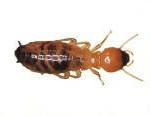

TERMITES
The Eastern Subterranean Termite, Reticulitermes flavipes (Kollar) is the most common and widely distributed termite in North America. It occurs south of the temperature line where the average annual minimum temperature is -220F. This includes southern Ontario, Canada, and southward through the eastern United States and into Texas.
RECOGNITION:
Swarmer. About 3/8" long including the wings. Its body is dark brown to
almost black. Fontanelle (frontal gland pore) present, may be inconspicuous.
Front wing has2 dark, heavily hardened veins in the front portion with the other
veins unpigmented except for the basal third. Wing which is translucent to
slightly smoky, the wing has a few barely visible hairs. Front wing size is
distinctly larger than hind wing, and may overlap the basal portion of the hind
wing.
Soldier. The head is rectangular in shape, not narrowed toward the front and the length is about 1.5 times width. Its mandibles lack teeth and it has tips, especially the left, curved in at about 70~90 degrees. The pronotum is flat and almost as wide as the head, with the width usually over 0.9mm.
DAMAGE: Subterranean
termites eat primarily spring wood and leave the lignin-containing summer wood
which they cannot effectively digest. Therefore, damaged wood appears to be
layered. And soil is typically found in the galleries.
A typical mature colony may consist of from 60,000 to well-over a million
workers. It is thought that approximately sixty thousand workers can eat 1/5
ounce or 5 grams of wood every day. Consuming at this rate, this theoretical
colony could completely consume just over 2 linear feet of a pine 2"x4" board in
about 1 year. The catch is that, there may be several colonies infesting a
single building.
BIOLOGY: Eastern
subterranean termites have 3 distinct castes: worker, soldier, and reproductive
(primary and secondary). Colony creation is through alates or swarmers flying
off in pairs, they then break off their wings and burrow into the soil, where
mating is completed and only a few eggs are produced during the first year. When
the queen is mature she will effectively produce about 5,000-10,000 eggs a year.
Queens may live for many years while workers may live only 1-2 years.
Several years are required before the colony reaches the typically mature size
of about 60,000+ workers. Under ideal conditions only a few alates / swarmers
may be produced after 3 to 4 years. Swarming generally occurs during the spring
but can possibly be followed by one or more smaller swarms until winter.
Swarming occurs during the daytime, typically during the morning of the day
following a warm rain after the soil heats to approximately 70 degrees F.
In the extreme northern United States and Canada, swarmers are very rarely seen. In this region, colony distribution is patchy because the termites are usually spread in infested wood and wood products such as lumber and firewood. The colony size is much larger, with colonies of 2-3 million foraging termites not uncommon. These large colonies forage over larger areas of up to 12,000 sq ft Termites actively feed in trees and free-standing poles as well as structures.
HABITS: The eastern subterranean termite colonies are usually located in the ground. The location is usually below the frost line, but above the water table and rock formations. Mud shelter tubes are built throughout the structure being infested and to cross areas of adverse conditions between the colony and food sources. They enter structures through cracks less than 1/16" (1-2 mm) wide. The space between the foundation and the first mortar joint is often enough space for termites to enter a home. However, if a constant source of moisture is available (like a leaky pipe), colonies (called secondary colonies) can exist above ground and without ground contact. Also, true aerial colonies (no ground contact ever existed) are known to exist. This is a particularly difficult problem in humid conditions such as Houston, Texas and along the Gulf Coast where normal wood moisture is from 8-12% while only 13-15% is necessary for termites to live just fine